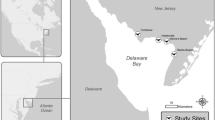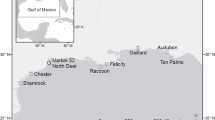Abstract
We investigated links between mining-related contaminants in river sediment and their occurrence in nestling ospreys (Pandion haliaetus) in the Clark Fork River Basin, Montana, USA. Blood and feather samples from 111 osprey chicks were collected during 4 years from nests along river sections with greatly different sediment concentrations of arsenic (As), cadmium (Cd), copper (Cu), lead (Pb), zinc (Zn), and mercury (Hg). No significant differences between river sections were found among Zn (3,150 ± 160 μg L−1) and Cd (<5 μg L−1) concentrations in blood. Cu, Pb, and As concentrations in blood were significantly increased in chicks from the most contaminated river sections (mean values of 298, 8.9, and 100 μg L−1, respectively). Cu, Zn, and Pb concentrations increased significantly during a year of above-average river runoff combined with high suspended sediment loads in rivers. Total Hg concentrations in blood and feathers were highly correlated and depended on the geographic locations of the nests. The lowest blood concentrations of Hg were observed in the most upstream river section (mean 151 μg L−1) where total sediment concentrations were increased (0.80 mg kg−1). River sections with intermediate blood concentrations (mean 206 and 303 μg L−1) were associated with low to intermediate sediment concentrations (0.058 and 0.46 mg kg−1). The highest concentrations of Hg in ospreys (mean 548 μg L−1) were observed downstream from a contaminated tributary (1–4 mg kg−1 in sediment). In river sections with lower Hg concentrations in sediment, there was a negative correlation between blood Hg concentration and chick mass, presumably due to high deposition rates into growing feathers. This relationship was absent in sections of high Hg exposure. Osprey blood and feathers are suitable for monitoring Hg in aquatic ecosystems; however, responses of As, Cd, Cu, Pb, and Zn are more subtle.





Similar content being viewed by others
References
Andersson A (1979) Mercury in soils. In: Nriagu JO (ed) The biogeochemistry of mercury in the environment. Elsevier, Amsterdam, pp 79–112
Blem CR, Bem LB, Harmata PJ (2002) Twine causes significant mortality in nestling Ospreys. Wilson Bull 114:528–529
Cain DJ, Luoma SN, Carter JL, Fend SV (1992) Aquatic insects as bioindicators of trace element contamination in cobble-bottom rivers and streams. Can J Fish Aquat Sci 49:2141–2154
Church ME, Gwiazda R, Risebrough RW, Sorenson K, Chamberlain CP, Farry S et al (2006) Ammunition is the principal source of lead accumulated by California condors re-introduced to the wild. Environ Sci Technol 40:6143–6150
Condon AM, Cristol DA (2009) Feather growth influences blood mercury level of young songbirds. Environ Toxicol Chem 28:395–401
Craighead D, Bedrosian B (2008) Blood lead levels of Common Ravens with access to big-game offal. J Wildl Manag 72:240–245
DesGranges L, Rodrigue J, Tardif B, Laperle M (1998) Mercury accumulation and biomagnification in ospreys (Pandion haliaetus) in the James Bay and Hudson Bay regions of Quebec. Arch Environ Contam Toxicol 35:330–341
DeWild JF, Olson ML, Olund SD (2002) Determination of methyl mercury by aqueous phase ethylation, followed by gas chromatographic separation with cold vapor atomic fluorescence detection. United States Geological Survey Open File Report 01-445
Eisler R (1993) Zinc hazards to fish, wildlife, and invertebrates: a synoptic review. Biological Report 10. United States Fish and Wildlife Service, Laurel, MD. Contaminant Hazard Reviews 26
Elliott JE, Machmer MM, Wilson LK, Henny CJ (2000) Contaminants in ospreys from the Pacific Northwest: II. Organochlorine pesticides, polychlorinated biphenyls, and mercury, 1991–1997. Arch Environ Contam Toxicol 38:93–106
Elliott JE, Morrissey CA, Henny CJ, Inzunza ER, Shaw P (2007) Satellite telemetry and prey sampling reveal contaminant sources to Pacific Northwest ospreys. Ecol Appl 17:1223–1233
Erry BV, Macnair MR, Meharg AA, Shore RF, Newton I (1999) Arsenic residues in predatory birds from an area of Britain with naturally and anthropogenically elevated arsenic levels. Environ Pollut 106:91–95
Farag AM, Woodward DF, Goldstein JN, Brumbaugh W, Meyer JS (1998) Concentrations of metals associated with mining waste in sediments, biofilm, benthic macroinvertebrates, and fish from the Coeur d’Alene River Basin, Idaho. Arch Environ Contam Toxicol 34:119–127
Garcá-Fernández AJ, Sanchez-Garcia JA, Gomez-Zapata M, Luna A (1996) Distribution of cadmium in blood and tissues of wild birds. Arch Environ Contam Toxicol 30:252–258
Gilbert SG, Weiss B (2006) A rationale for lowering the blood lead action level from 10 to 2 mg/dL. Neurotoxicology 27:693–701
Golden NH, Rattner BA (2003) Ranking terrestrial vertebrate species for utility in biomonitoring and vulnerability to environmental contaminants. Rev Environ Contam Toxicol 176:67–136
Golden NH, Rattner BA, McGowan PC, Parsons KC, Ottinger MA (2003) Concentrations of metals in feathers and blood of nestling black-crowned night-herons (Nycticorax nycticorax) in Chesapeake and Delaware Bays. Bull Environ Contam Toxicol 70:0385–0393
Grove RA, Henny CJ, Kaiser JL (2009) Osprey: worldwide sentinel species for assessing and monitoring environmental contamination in rivers, lakes, reservoirs, and estuaries. J Toxicol Environ Health B 12:25–44
Harris RC, Rudd JWM, Amyot M, Babiarz CL, Beaty KG, Blanchfield PJ et al (2007) Whole-ecosystem study shows rapid fish-mercury response to changes in mercury deposition. Proc Natl Acad Sci USA 104:16586–16591
Henny CJ, Blus LJ, Hoffman DJ, Grove RA, Hatfield JS (1991) Lead accumulation and osprey production near a mining site on the Coeur d’Alene River, Idaho. Arch Environ Contam Toxicol 21:415–424
Henny C, Grove R, Kaiser J, Johnson B (2010) North American osprey populations and contaminants: historic and contemporary perspectives. J Toxicol Environ Health B Crit Rev 13:579–603
Hermayer KL, Stake PE, Shippe RL (1977) Evaluation of dietary zinc, cadmium, tin, lead, bismuth and arsenic toxicity in hens. Poult Sci 56:1721–1722
Hopkins WA, Hopkins LB, Unrine JM, Snodgrass J, Elliot JD (2007) Mercury concentrations in tissues of osprey from the Carolinas, USA. J Wildl Manag 71:1819–1829
Houston CS, Scott F (2006) Entanglement threatens ospreys at Saskatchewan nest. J Raptor Res 40:226–228
Krabbenhoft DP, Wiener JG, Brumbaugh WG, Olson ML, DeWild JF, Sabin TJ (1999) A national pilot study of mercury contamination of aquatic ecosystems along multiple gradients. Water-Resources Investigation Report 99-4018B. United States Geological Survey, Reston
MacDonald DD, Ingersoll CG, Berger TA (2000) Development and evaluation of consensus-based sediment quality guidelines for freshwater ecosystems. Arch Environ Contam Toxicol 39:20–31
Marvin-DiPasquale M, Lutz MA, Brigham ME, Krabbenhoft DP, Aiken GR, Orem WH et al (2009) Mercury in stream ecosystems. 2. Benthic methylmercury production and bed sediment–pore water partitioning. Environ Sci Technol 43:2726–2732
Moore JN, Luoma SN (1990) Hazardous wastes from large-scale metal extraction. Environ Sci Technol 24:1279–1284
Moore JN, Luoma SN, Peters D (1991) Downstream effects of mine effluent on an intermontane riparian system. Can J Fish Aquat Sci 48:222–232
Rattner BA, Golden NH, Toschik PC, McGowan PC, Custer TW (2008) Concentrations of metals in blood and feathers of nestling ospreys (Pandion haliaetus) in Chesapeake and Delaware Bays. Arch Environ Contam Toxicol 54:114–122
Rivera-Rodríguez LB, Rodríguez-Estrella R (2011) Incidence of organochlorine pesticides and the health condition of nestling ospreys (Pandion haliaetus) at Laguna San Ignacio, a pristine area of Baja California Sur, Mexico. Ecotoxicology 20:29–38
Sando SK, Lambing JH (2011) Estimated loads of suspended sediment and selected trace elements transported through the Clark Fork basin, Montana, in selected periods before and after the breach of Milltown Dam (water years 1985–2009). United States Geological Survey Scientific Investigations Report 2011-5030
Savinov VM, Gabrielsen GW, Savinova TN (2003) Cadmium, zinc, copper, arsenic, selenium and mercury in seabirds from the Barents Sea: levels, inter-specific and geographical differences. Sci Total Environ 306:133–158
Scheuhammer AM (1987) The chronic toxicity of aluminium, cadmium, mercury, and lead in birds: a review. Environ Pollut 46:263–295
Schuster PF, Krabbenhoft DP, Naftz DL, Cecil LD, Olson ML, DeWild JF et al (2002) Atmospheric mercury deposition during the last 270 years: a glacial ice core record of natural and anthropogenic sources. Environ Sci Technol 36:2303–2310
Shelton LR, Capel PD (1994) Guidelines for collecting and processing samples of stream bed sediment for analysis of trace elements and organic contaminants for the National Water-Quality Assessment Program. United States Geological Survey Open-File Report 94-458, pp 1–31
Toschik PC, Rattner BA, McGowan PC, Christman MC, Carter DB, Hale RC et al (2005) Effects of contaminant exposure on reproductive success of ospreys (Pandion haliaetus) nesting in Delaware River and Bay, USA. Environ Toxicol Chem 24:617–628
United States Environmental Protection Agency (2004) Clark Fork River operable unit of the Milltown Reservoir/Clark Fork River superfund site, record of decision. EPA/ROD/R08-04/100:1-447. USEPA Region 8, Helena, MT
United States Environmental Protection Agency (2008) Model-based analysis and tracking of airborne mercury emissions to assist in watershed planning. USEPA, Office of Wetlands, Oceans and Watersheds, Watershed Branch, Washington, DC
United States Environmental Protection Agency (2011) Clark Fork River Operable Unit Region 8. http://www.epa.gov/region8/superfund/mt/milltowncfr/cfr/. Accessed 28 Jan 2011
Wiemeyer SN, Schmeling SK, Anderson A (1987) Environmental pollutant and necropsy data for ospreys from the eastern United States, 1975–1982. J Wildl Dis 23:279–291
Woodward DF, Brumbaugh WG, Delonay AJ, Little EE, Smith CE (1994) Effects on rainbow trout fry of a metals-contaminated diet of benthic invertebrates from the Clark Fork River, Montana. Trans Am Fish Soc 123:51–62
Yao Z, Gao P (2007) Heavy metal research in lacustrine sediment: a review. Chin J Oceanol Limnol 25:444–454
Acknowledgments
We thank the Montana State Natural Resource Damage Program and the Environmental Biogeochemistry Laboratory at the University of Montana Geosciences Department for partial funding of this research. Special thanks go to Dave Taylor Roofing of Missoula, MT, Sam Milodragovich and Roy Brunner of Northwestern Energy Corporation, and Bart Peterson of Missoula Electric Cooperative for making their boom trucks available. We also thank personnel from Grant-Kohrs Ranch National Historic Site, Atlantic Richfield Company, Tammy Talley, and Riverside Health Care Center, as well as the many private land owners who graciously gave us access to osprey nests. Kate Davis of Raptors of the Rockies, Karen Wagner, and an anonymous donor also helped facilitate this research in various ways. We thank three anonymous reviewers for their thorough and thoughtful comments, which greatly improved an earlier draft of this manuscript.
Author information
Authors and Affiliations
Corresponding author
Rights and permissions
About this article
Cite this article
Langner, H.W., Greene, E., Domenech, R. et al. Mercury and Other Mining-Related Contaminants in Ospreys Along the Upper Clark Fork River, Montana, USA. Arch Environ Contam Toxicol 62, 681–695 (2012). https://doi.org/10.1007/s00244-011-9732-5
Received:
Accepted:
Published:
Issue Date:
DOI: https://doi.org/10.1007/s00244-011-9732-5




